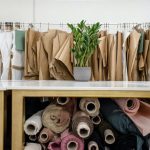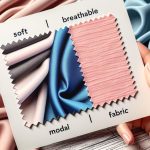When it comes to choosing the best fabric for your garments and home textiles, the decision between rayon and modal can be as intricate as the threads themselves. Understanding the nuances of each fabric will empower you to make informed choices.
In this comparison, we'll delve into the origins, properties, comfort, durability, versatility, and environmental impact of rayon and modal. By the end, you'll have a comprehensive understanding of these fabrics, allowing you to confidently select the best option for your specific needs.
Let's unravel the intricacies of rayon and modal to discover which fabric truly stands as the pinnacle of quality and suitability.
Key Takeaways
- Rayon production is associated with deforestation and pollution, while Modal is considered more environmentally friendly due to renewable materials and waste reduction.
- Modal is softer, more absorbent, and more durable than Rayon, making it a popular choice for clothing and bedding.
- Modal excels in moisture-wicking, keeping you drier and more comfortable compared to Rayon.
- Both Rayon and Modal fabrics require proper care and maintenance for durability, but Rayon is known for exceptional softness while Modal offers luxury and comfort.
Origins of Rayon and Modal
The origins of Rayon and Modal date back to the late 19th and early 20th centuries, marking significant advancements in textile production. Rayon, the first man-made fiber, was developed in the late 19th century, while Modal, a type of rayon, was developed in the 1950s.
The production process for Rayon involves dissolving wood pulp to form a viscous solution that's then extruded to form fibers. In contrast, the production of Modal involves spinning reconstituted cellulose, often from beech trees, to create fibers.
The environmental impact of these two fibers differs significantly. The production of Rayon involves the use of harsh chemicals and has been associated with environmental concerns such as deforestation and pollution. On the other hand, Modal is considered more environmentally friendly as it's made from renewable materials and the production process is designed to minimize waste and emissions.
Understanding the differences in their production processes and environmental impacts can help consumers make informed decisions about which fabric is best suited for their needs.
Properties and Characteristics
When comparing rayon and modal, it's important to consider their strength and softness. Understanding the differences in these characteristics will help you make an informed decision about which fabric best suits your needs.
Additionally, it's important to consider the breathability and moisture-wicking properties of both fabrics. These factors play a significant role in determining the comfort level of the fabric.
Let's explore how rayon and modal stack up against each other in terms of these key properties.
Rayon Vs Modal
When considering rayon vs modal, you'll find that both fabrics share similar properties and characteristics. Rayon and modal are both semi-synthetic fabrics made from cellulose fibers, making them breathable and comfortable to wear. However, there are some material differences that set them apart.
| Property | Rayon | Modal |
|---|---|---|
| Softness | Not as soft as modal | Incredibly soft and smooth |
| Moisture Absorption | Absorbs moisture well | Highly absorbent, more so than cotton |
| Durability | Less durable than modal | Highly durable and resistant to pilling |
| Eco-Friendliness | Less eco-friendly due to manufacturing process | More eco-friendly due to closed-loop production |
Understanding these fabric comparisons can help you make an informed decision about which fabric best suits your needs.
Strength and Softness
- To truly understand the differences between rayon and modal, you need to feel the strength and softness of each fabric firsthand. When comparing the strength of the two fabrics, modal is generally considered to be stronger than rayon. This is due to its higher wet strength, making it less prone to stretching or losing shape when wet. However, rayon is known for its exceptional softness, often described as luxurious and silky to the touch.
- In terms of softness measurement, modal is also incredibly soft and smooth, with a gentle drape that feels comforting against the skin. In contrast, while rayon is soft, it may not possess the same level of smoothness and silkiness as modal.
- Ultimately, your choice will depend on whether you prioritize strength or softness.
Breathability and Moisture-Wicking
Comparing the breathability and moisture-wicking properties of rayon and modal, you'll find that each fabric offers distinct advantages in keeping you cool and dry.
Rayon, while breathable, has a lower moisture-wicking ability compared to modal.
Modal, on the other hand, excels in moisture-wicking, drawing moisture away from the skin to the exterior of the fabric where it can evaporate more easily, thus keeping you drier and more comfortable. This enhanced moisture-wicking ability also contributes to modal's breathability, as it prevents moisture from becoming trapped between the fabric and your skin, allowing for better air circulation.
In essence, if you prioritize staying cool and dry, especially during physical activities or in warm climates, modal's superior moisture-wicking and breathability make it the fabric of choice.
Comfort and Softness
When it comes to comfort and softness, rayon's breathability advantage can make a noticeable difference in your overall comfort. The fabric allows for better air circulation, which can help keep you cool and comfortable in warm weather.
On the other hand, modal's luxurious silky feel provides a smooth and soft texture against your skin, offering a sense of luxury and comfort.
Rayon's Breathability Advantage
You'll appreciate the exceptional breathability and comfort of rayon fabric, making it a great choice for soft and airy clothing. Rayon's unique properties make it an ideal fabric for those seeking both comfort and style.
Here's why rayon's breathability advantage sets it apart:
- Airy Feel: Rayon's open structure allows for better air circulation, keeping you cool and comfortable, especially in warm weather.
- Moisture Absorption: It efficiently absorbs moisture, keeping you dry and comfortable throughout the day.
- Softness: The smooth texture of rayon fabric feels luxurious against the skin, providing unparalleled comfort.
- Versatility: Rayon's breathability makes it suitable for a wide range of clothing items, from casual wear to formal attire.
Rayon's breathability advantage makes it a top choice for those who prioritize comfort without compromising style.
Modal's Luxurious Silky Feel
Modal's luxurious silky feel enhances your comfort and softness, offering a distinct alternative to rayon's breathability advantage.
The silk-like texture of Modal fabric is achieved through the use of beech tree fibers, resulting in a material that feels exceptionally smooth and luxurious against your skin.
When compared to rayon, Modal's superior softness and comfort make it a popular choice for clothing, bedding, and other textiles.
The unique blend of softness and breathability sets Modal apart, providing a sumptuous feel without compromising on airflow. This makes it an ideal choice for garments and linens where both comfort and breathability are essential.
In the fabric comparison between rayon and Modal, the latter's luxurious silky feel undoubtedly stands out, offering a truly indulgent experience.
Durability and Maintenance
Proper care and regular maintenance are key to ensuring the durability of both rayon and modal fabrics. When comparing their durability, it's important to note that both fabrics are prone to shrinking, stretching, and wrinkling if not properly cared for.
Here are some maintenance tips to help you preserve the quality of your rayon and modal garments:
- Hand Wash or Gentle Cycle: To maintain the integrity of the fibers, hand wash your rayon and modal garments in cold water, or use the gentle cycle on your washing machine.
- Avoid Heat: Heat can be detrimental to these fabrics, so it's crucial to avoid high heat when washing or drying. Opt for air drying or using the lowest heat setting on your dryer.
- Store Carefully: To prevent stretching or misshaping, store your rayon and modal clothing items folded rather than hanging.
- Handle with Care: When ironing, use a low heat setting and place a cloth between the iron and the fabric to avoid damage.
Versatility in Fashion and Home Textiles
Frequently, you can incorporate rayon or modal fabrics into your fashion and home textile choices for their versatility and comfort.
Rayon and modal fabrics offer a wide range of design opportunities due to their ability to mimic the texture and drape of natural fibers like silk, cotton, and wool. In fashion, these fabrics are favored for their adaptability to various design trends. Whether it's the fluidity of a maxi dress, the softness of a blouse, or the breathability of summer shorts, these fabrics can effortlessly translate diverse fashion sensibilities.
Moreover, their versatility extends to interior decor. From draperies and upholstery to bedding and decorative pillows, rayon and modal are equally at home in home textiles. Their ability to blend seamlessly with different styles, from contemporary to traditional, makes them a popular choice for interior designers.
In essence, rayon and modal fabrics offer a harmonious blend of style and comfort, making them a valuable choice for both fashion and interior decor, with the added benefit of being environmentally sustainable.
Environmental Impact and Sustainability
The environmental impact and sustainability of rayon and modal fabrics are important considerations in both fashion and home textiles. When evaluating these factors, it's crucial to consider the following:
- Environmental Impact: Both rayon and modal are made from wood pulp, which comes from trees. However, the production of modal involves a closed-loop process, where the chemicals used to break down the wood pulp are captured and reused, resulting in minimal environmental impact. In contrast, the production of rayon often involves more environmentally harmful processes, such as the release of carbon disulfide and other toxic chemicals into the environment.
- Sustainable Practices: Modal is often considered more sustainable than rayon due to its manufacturing process. The closed-loop process used in modal production reduces chemical waste and water consumption, making it a more environmentally friendly option. Additionally, modal is often produced from beech trees, which are known for their fast growth and minimal impact on ecosystems.
- Certifications: Look for fabrics that have been certified by organizations such as the Forest Stewardship Council (FSC) or the OEKO-TEX Standard 100, as these certifications ensure that the materials used are sustainably sourced and free from harmful substances.
- Longevity and Durability: Consider the longevity and durability of the fabrics. Modal is known for its strength and resistance to pilling, which means it may have a longer lifespan compared to other fabrics, reducing the overall environmental impact of textile production and waste.
When considering the environmental impact and sustainability of rayon and modal, it's important to weigh these factors in your purchasing decisions.
Frequently Asked Questions
Are There Any Potential Health Concerns Associated With Wearing Rayon or Modal Fabric?
Wearing rayon or modal fabric may pose potential allergies due to the chemical processing involved. While both fabrics are derived from natural materials, the environmental impact of their production should also be considered.
How Do Rayon and Modal Fabrics Compare in Terms of Color Retention and Resistance to Fading?
When it comes to color retention, rayon and modal fabrics have different characteristics. Understanding these differences will help you make informed decisions about which fabric will best meet your needs for durability and long-lasting color vibrancy.
Can Rayon and Modal Fabrics Be Used for Outdoor or Active Wear, Such as in Sports Clothing?
For outdoor wear and sports clothing, both rayon and modal fabrics offer great breathability and moisture-wicking properties. They are comfortable, lightweight, and ideal for active pursuits, making them suitable choices for athletic apparel.
Are There Any Specific Care Instructions for Washing and Drying Rayon and Modal Fabrics?
When washing rayon and modal fabrics, use mild detergent and cold water to prevent shrinkage and color bleeding. Afterward, gently squeeze out excess water and lay flat to dry to maintain the fabric's shape and color.
Are There Any Ethical or Labor-Related Considerations to Be Aware of When Purchasing Rayon or Modal Products?
When considering ethical sourcing, labor conditions, sustainability, and environmental impact, it's important to be aware of the potential impact of purchasing rayon or modal products. Understanding these factors can help you make informed purchasing decisions.
- How Does Ring Spun Cotton Affect Garment Fit and Shape Retention? - August 13, 2024
- What Are the Challenges in Producing Ring Spun Cotton? - August 13, 2024
- Is Ring Spun Cotton Suitable for Plus-Size Clothing? - August 13, 2024






